BIDENS
Bidens
L., Sp. Pl. 2: 831. 1753; Collett, Fl. Siml. ed. 2: 263. 1921 (Reprint 1980); Fl. China @ eFloras.org 20-21: 857; Strother & Weedon, Fl. North Amer. @ eFloras.org 21: 205.
Annual or perennial herbs and vines. Stem usually erect, often branched distally or throughout. Leaves usually cauline, usually opposite, rarely alternate or whorled; petiolate or sessile; leaf blade simple, compound or 1-3-pinnatisect or pinnately lobed with segments linear to broadly ovate, ultimate margins entire, dentate, toothed, serrate or laciniate, both surfaces usually glabrous, sometimes hairy. Capitula usually radiate or discoid, sometimes discifom, usually in corymbiform arrays or borne singly. Calycular bracts erect spreading or reflexed, herbaceous. Involucres mostly hemispheric or campanulate to cylindric. Phyllaries persistent, mostly 8-21 in +/- 2 series, usually free, sometimes connate at base, mostly oblong or ovate to oblong-lanceolate, margin usually hyaline. Receptacle flat or slightly convex, paleate, paleae usually deciduous, straw-coloured. Ray florets usually 1-seriate, usually neuter, sometimes female and sterile. Corollas usually yellow, sometimes white or pinkish. Disc florets bisexual, fertile. Corollas usually yellow to orange, sometimes whitish or purplish, tubes shorter than throats, lobes (3-) 5, deltate. Staminal filaments glabrous. Style branch tips deltate, lanceolate or subulate. Cypselae (Achenes) usually compressed, obcompressed (unequally 3-4 angled) or flat; cuneate, oblanceolate or obovate, sometimes all or inner +/- equally 4-angled and linear-fusiform, rarely subterete; striate-sulcate, ribbed, unmargined or margins narrowly winged or callose thickened, margins usually retrosely, sometimes patently or antrorsely barbed or ciliate; apices sometimes attenuate, not beaked. Pappi 0 or persistent of (1-) 2-4 (-8), usually retrosely sometimes antrorsely barbellate or ciliate, rarely smooth awns.
222 species
Bidens pilosa
Bidens pilosa
L., Sp. Pl. 2: 832. 1753; Fl. China @ eFloras.org 20-21: 859; Fl. North Amer. @ eFloras.org 21: 211.
Annual herbs, 30-180 cm tall. Stems erect, branched, glabrous or sparsely pubescent in distal part. Leaves opposite; petiole 1-3 cm long, narrowly winged, glabrous or pubescent; leaf blade 1-pinnately lobed, lobes usually 3, ovate, ovate-rhombic to lanceolate, 2.5-8 cm x 1-4 cm, both surfaces glabrate, bases cuneate to attenuate, ultimate margin serrate or entire, apices acute to attenuate. Capitula radiate, usually borne singly, sometimes in open +/- corymbiform arrays. Peduncles 1-2(-8) cm, puberulent. Involucre turbinate to campanulate, 5-6 mm x 7-8 mm. Phyllaries in 2 series: outer phyllaries 6-9, green herbaceous appressed, spatulate to linear, 3-5 mm long, margins ciliate, abaxial faces usually hispidulous to puberulent; inner phyllaries 7-9, lanceolate to oblanceolate, 4-6 mm long, pale yellow. Ray florets: 5-8, 1-seriate, neuter. Corolla whitish (to pinkish), 5-15 mm long; limb usually 3- lobed. Disc florets: 20-40+, bisexual, fertile. Corolla usually yellow, 3-5 mm long; tubes shorter than throats; lobes 5, deltate, reflexed. Staminal filaments glabrous. Cypselae (Achenes) slightly curved, stiff, rough. Outer red-brown or black, +/- flat, linear to narrowly cuneate, 3-5+ mm, faces obscurely 2-grooved, sometimes tuberculate hispidulous, apices +/- truncate or somewhat attenuate; inner blackish, rod-like, +/- equally 4-angled, linear- fusiform, 7-16 mm long, margins antrorsely hispidulous, apices +/- attenuate, faces 2-grooved, tuberculate-hispidulous to sparsely strigillose. Pappi of 2-5, usually erect, rarely divergent, stiff, retrosely barbed awns, 2-4 mm.
Common Names: Black jack, Beggar’s Tick, Farmer’s friends, Spanish Needle, Cobbler’s pegs; Kumra, Kumar, Kurei (Hindi)
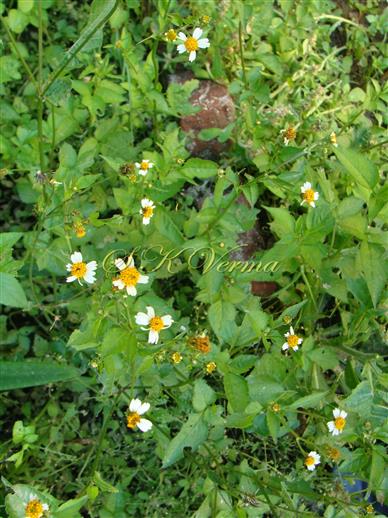
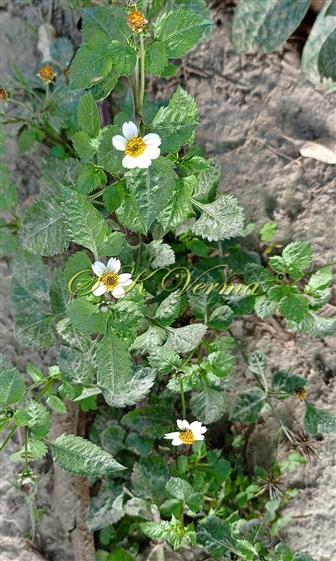

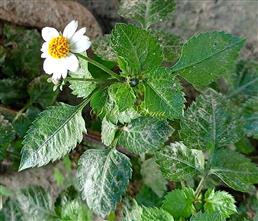
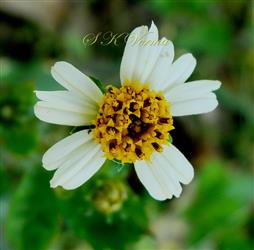
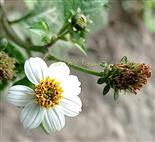
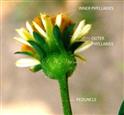
-1754.jpg)
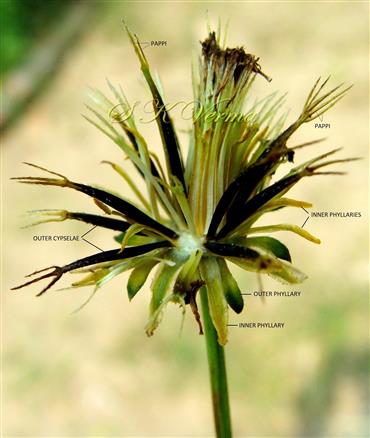
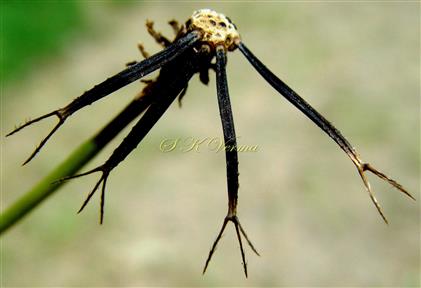








-1754.jpg)

